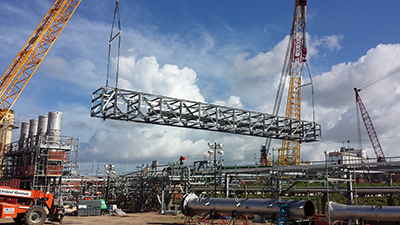 A new industrial project in Freeport, Texas, illustrates a portion of the energy industry that is sometimes overlooked but nevertheless crucial to the conversation. While oil—particularly in terms of imports—renewable energy and even coal have dominated the current narrative, liquefied petroleum gas (LPG, often referred to as propane or butane) is a big part of the energy puzzle. And the new Phillips 66 Freeport LPG Export Terminal, due south of Houston on the Gulf Coast, is now exporting over 4 million barrels of LPG per year to Europe and Asia. But to accommodate this new capacity, the existing 100-acre facility required 36 miles of new piping, the majority of which was installed on steel pipe racks.
A new industrial project in Freeport, Texas, illustrates a portion of the energy industry that is sometimes overlooked but nevertheless crucial to the conversation. While oil—particularly in terms of imports—renewable energy and even coal have dominated the current narrative, liquefied petroleum gas (LPG, often referred to as propane or butane) is a big part of the energy puzzle. And the new Phillips 66 Freeport LPG Export Terminal, due south of Houston on the Gulf Coast, is now exporting over 4 million barrels of LPG per year to Europe and Asia. But to accommodate this new capacity, the existing 100-acre facility required 36 miles of new piping, the majority of which was installed on steel pipe racks.
When it came to designing the system, structural engineer Burns and McDonnell (BMcD) determined that the project’s compressed construction schedule and project site removed typical built-in-place or stick-built framing as feasible options. Luckily, BMcD had success with modular steel framing in the past, and that’s the approach it took for the terminal project.
For this particular project, which used 6,150 tons of steel in all, modular construction provided several advantages over standard stick-built erection, including a reduced schedule and the subsequent monetary savings—but the most important advantage was safety. Construction sites are busy and congested, making them a potentially hazardous work environment. By designing the pipe racks as modules, it allowed for a significant number of the steel and piping construction hours to be removed from the job site and shifted to the module shop where ironworkers and pipefitters could work in a more controlled environment. Multi-level modules were erected, filled with pipe and cable tray, insulated and fireproofed at ground level, then shipped to the site and installed in their final locations.
For more about the project, see the article “Coastal Construction” in our December issue (available now!).